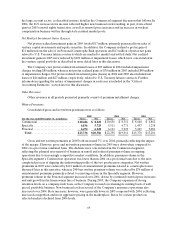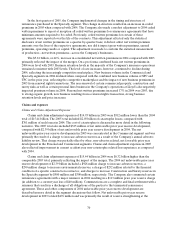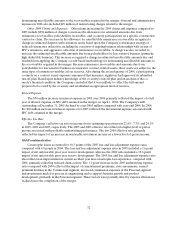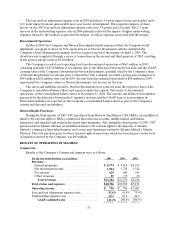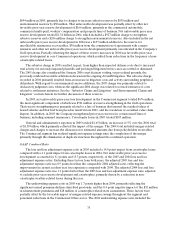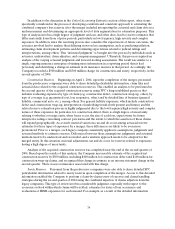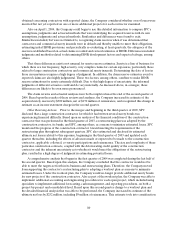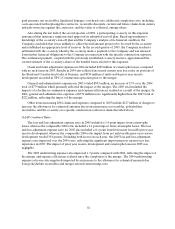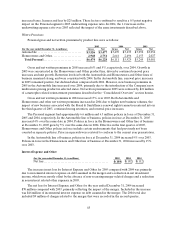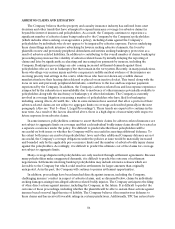Travelers 2005 Annual Report Download - page 91
Download and view the complete annual report
Please find page 91 of the 2005 Travelers annual report below. You can navigate through the pages in the report by either clicking on the pages listed below, or by using the keyword search tool below to find specific information within the annual report.79
In addition to the discussion in the Critical Accounting Estimates section of this report, other items
specifically considered in the process of developinga uniform and consistent approach to estimating the
combined company’s loss reserves after the merger included interpreting the actuarial and claim data in a
uniform manner and determining an appropriate level of data segmentation for estimation purposes. This
type of analysis involves a high degree of judgment and can, and often does, lead to reserve estimates that
differ materially from those of prior periods, particularly in low frequency, high severity and complex
exposures. In addition, since the reserving process also considers the expectations of future outcomes, the
actuaries involved had to analyze their differing views on key assumptions, such as predicting inflation,
estimating claim development patterns and determining expectations related to judicial rulings and
interpretations, among others. This “informed judgment” is brought into the process by individuals such as
actuaries, underwriters, claim adjusters, and company management. Ultimately, this process required an
analysis of the varying actuarial judgments and forward-looking assessments. The result was similar to a
single, ongoing insurance enterprise obtaining more information in a reporting period than it had
previously and identifying a change in estimate in its insurance reserves in that period. Accordingly, the
Company recorded a $500 million and $300 million charge for construction and surety, respectively, in the
second quarter of 2004.
Construction Reserves. Beginning on April 1, 2004, upon the completion of the merger, personnel
from the predecessor companies were able to share detailed policyholder information, claim files and
actuarial data related to the acquired construction reserves. This enabled an analysis to be performed in
the second quarter of the acquired construction reserves using TPC’s long-established practices that
includes evaluating exposures by type of claim (e.g. construction defect, construction wrap-up, other), by
type of coverage (e.g. guaranteed cost, loss responsive, other) and by detailed line of business (general
liability, commercial auto, etc.), among others. For general liability exposures, which include construction
defect and construction wrap-up, interpretation of underlying trends (both present and future) and the
related reserve estimation process is highly judgmentaldue to the low frequency/high severity and complex
nature of these exposures. In particular, for construction defect, there is a high degree of uncertainty
relating to whether coverage exists, when losses occur, the size of each loss, expectations for future
interpretive rulings concerning contract provisions and the extent to which the assertion of these claims
will expand geographically. As a result, material variations can and do occur among actuarial reserve
estimates for these types of exposures. In a merger, these differences are likely to be even more
pronounced. Prior to a merger, each legacy company consistently applies its assumptions, judgments and
actuarial methods to estimate reserves. Differences between these assumptions, judgments and actuarial
methods need to be understood and reconciled, and a uniform approach needs to be adopted for the
merged entity. In this situation, material adjustments can and do occur for reserves related to exposures
having a highdegree of uncertainty.
Analysis of the acquired construction reserves was completed near the end of the second quarter of
2004. Based upon the results of this analysis, the Company increased its estimate of the acquired net
construction reserves by $500 million, including $400 million for construction defect and $100 million for
construction wrap-up claims, and recognized this change in estimate as an income statement charge in the
second quarter. There was no reinsurance associated with this charge.
Surety Reserves. Personnel from the predecessor companies were also able to share detailed SPC
policyholder information related to surety reserves upon completion of the merger. Access to this detailed
information enabled the Company to perform a claim-by-claim review of reserves and claims handling
strategies during the secondquarter of 2004 using the combined expertise of claims adjusters from the
legacy companies. This type of review involves considerable judgment, especially with respect to the
economic outlook within which claims will be settled, estimates for dates of loss occurrence and
evaluations of IBNR exposures for each insured. For example, as a result of the detailed information


